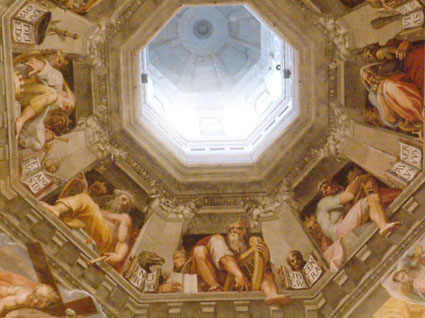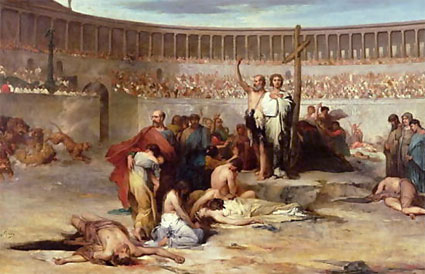Dec
17
2009

On the AV forum, full-pret Dave asks a good question:
“Since your view distinguishes between the parousia of AD70 and a future return of Christ at ‘the end’, when Christ and the apostles taught about the ‘Second Coming’ (yet to occur), what did they call that event?”
Continue reading
6 comments | tags: Against Hyperpreterism | posted in Against Hyperpreterism, Biblical Theology, The Last Days
Sep
24
2009

“According to I Chronicles chapter 15, 16:4-6, 37-43, David rearranged the Levitical priesthood into 24 courses (orders); he assigned 16 courses to Eleazer, and 8 courses to Ithamar. This rearrangement was chartered because of a population explosion in David’s reign.” [1]
More evidence for a human government installed in heaven in AD70 (the firstfruits church). If the rebuilt Tabernacle (the Tabernacle of David [2]) prefigured both the restoration of the Jews after the captivity (which is what Amos is actually referring to) and the Jew-Gentile church, what could David’s rearranged priesthood mean typologically?
Continue reading
Comments Off | tags: AD70, Against Hyperpreterism, Amos, Baptism, Bible Matrix, Feasts, Firstfruits, Jericho, New Jerusalem, Revelation, Tabernacle, Tabernacles | posted in Against Hyperpreterism, Biblical Theology, The Last Days, The Restoration Era, Totus Christus
Sep
22
2009

“For then there will be great tribulation, such as has not been since the beginning of the world until this time, no, nor ever shall be. And unless those days were shortened, no flesh would be saved; but for the elect’s sake those days will be shortened.” Matthew 24:21-22
The context of Matthew 23-25 is very clearly first century. Many interpreters are forced to put gaps and parentheses and qualifiers into Jesus’ warnings because they won’t recognise what happened in the last years of the Old Covenant.[1]
Continue reading
5 comments | tags: AD70, Against Hyperpreterism, Martyrdom, Matthew, Resurrection, Revelation 20, Satan, Tribulation | posted in Against Hyperpreterism, The Last Days
Aug
14
2009

or Filling Up That Which is Lacking
After reading about the Bible’s use of robes as symbols of office (see The Dominion Trap by James B. Jordan), Tim Mitchell commented:
In Bible study we’ve been looking at John, so a few weeks ago was John 13. My Bible translated v.4-5 as “So he got up from the table, took off his robe, wrapped a towel around his waist, and poured water into a basin. Then he began to wash the disciples’ feel, drying them with the towel he had around him.”
So that recalled for me the couple of pages on robe imagery, and it seems to foreshadow what Jesus will do later on very well: He is willing to take off his authority and righteousness, and take on the dirt of our sin.
But then I got a bit unsure, since Jesus then goes on to say “you ought to wash each others’ feet” in v.14 and “Do as I have done to you” in v.15. So if the symbolism applies, how are we also supposed to take other peoples’ sin on us as Jesus did?
Firstly, what a great question. Many New Testament passages become so familiar that we often lose the ability to really think about their ramifications.
The structure of the Last Supper puts this action of Jesus at Atonement, the Laver (Day 6). Jesus is liturgically pre-enacting His role as High Priest. The Adam removed his glorious robes and wore linen for the Day of Covering. Jesus left this in the tomb with our sin on it. But that is not all the High Priest did. He approached the Most Holy twice.
Continue reading
Comments Off | tags: AD70, Against Hyperpreterism, Ahasuerus, Atonement, Daniel, Esther, Hebrews, High Priest, Holy Place, Joseph, Last Supper, Liturgy, Totus Christus | posted in Biblical Theology, Christian Life, Totus Christus
Jul
14
2009

or Theonomy in the Bible
“…instead of Moses and Aaron challenging the powers that be, we have Herodian preachers crying “Peace, peace” when there is no peace. Nathan is not qualified to confront David because Nathan himself has been sleeping around.”
In his post Christianity as Comprehensive Cultural Tribunal?, timsmartt questions the validity of philosophy’s self-appointed role as an unbiased cultural referee and wonders whether Christianity should take that role:
Continue reading
Comments Off | tags: Aaron, Abraham, Against Hyperpreterism, antichrist, Daniel, Esther, Herod, Jethro, John the Baptist, Korah, Melchizedek, Mordecai, Moses, Nathan, Philosophy, Postmillennialism, Solomon | posted in Biblical Theology, The Last Days, The Restoration Era
Jul
6
2009

If we don’t get Genesis right, we’ll get much of the Bible wrong. In Through New Eyes (PDF), James Jordan identifies a three-level “cosmos” in the Creation, which is reflected on the earth. There is the Garden Sanctuary, the Land of Eden, and the Outlying Lands, or Garden, Land and World.
This is reflected, not only in the ark of Noah, but also in the Tabernacle. The image is dual, one in heaven and one on earth:
Continue reading
Comments Off | tags: Against Hyperpreterism, Altar, Babel, oikoumene, Paul, Tabernacle | posted in Against Hyperpreterism, Biblical Theology, The Last Days
Jun
30
2009
 “And their dead bodies will lie in the street of the great city which spiritually is called Sodom and Egypt, where also our Lord was crucified.” – Revelation 11:8
“And their dead bodies will lie in the street of the great city which spiritually is called Sodom and Egypt, where also our Lord was crucified.” – Revelation 11:8
Revelation 20 makes it clear that the “second death” is the lake of fire. But an analysis of the literary structure of Revelation brings out an interesting factor.
Continue reading
Comments Off | tags: Against Hyperpreterism, Armageddon, Atonement, Azal, Egypt, Feasts, James Jordan, Passover, Peter Leithart, Revelation 20, Smyrna, Sodom, Systematic typology, Tabernacle | posted in Biblical Theology, The Last Days, Totus Christus
May
27
2009
The LORD called out to the man and asked, “Where are you?” Genesis 3:9
For those who wonder why God doesn’t fix all the wrong in the world right now, C. S. Lewis wrote that when the Author walks onto the stage, the play is over. That is true, but narrow…
Continue reading
Comments Off | tags: Adam, Against Hyperpreterism, C. S. Lewis, Dominion, Fatherhood, Mediator, Postmillennialism | posted in Christian Life, Ethics, The Last Days
Apr
23
2009
“And the God of peace will crush Satan under your feet shortly.” Romans 16:20
James Jordan commented in one of his lectures that some churches had a serpent painted on the floor in the doorway. The saints trod him under foot as they entered God’s house to worship.
Continue reading
Comments Off | tags: Against Hyperpreterism, High Priest, James Jordan, Jericho, Joshua, Satan, Totus Christus | posted in Against Hyperpreterism, Biblical Theology, Totus Christus
Apr
19
2009
or The Feasts are the Key to the Revelation
All Christians recognise Christ’s fulfilment of Passover (crucifixion) and Firstfruits (ascension), followed by Pentecost. Futurists, who major on all things Jewish, recognise that Trumpets and Atonement follow, but they push them into the future.
Continue reading
Comments Off | tags: Acts, AD70, Against Hyperpreterism, Atonement, Dispensationalism, Herod, Holy war, Jezebel, Passover, Totus Christus, Trumpets | posted in Against Hyperpreterism, Biblical Theology, The Last Days
































